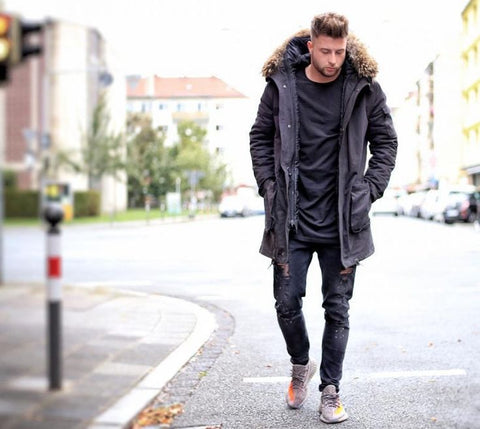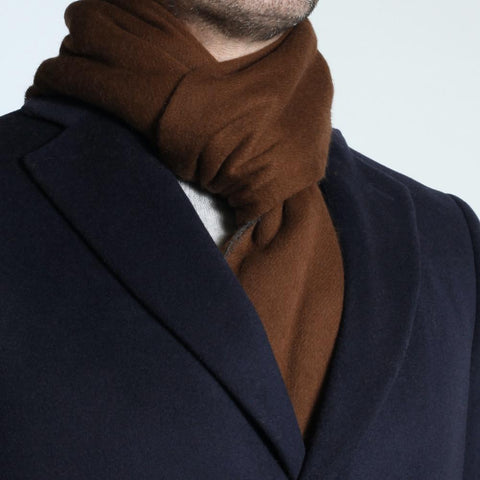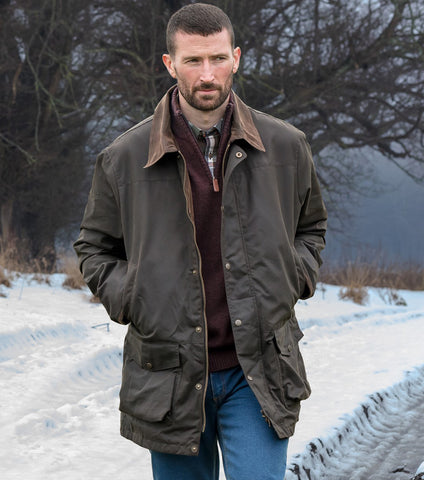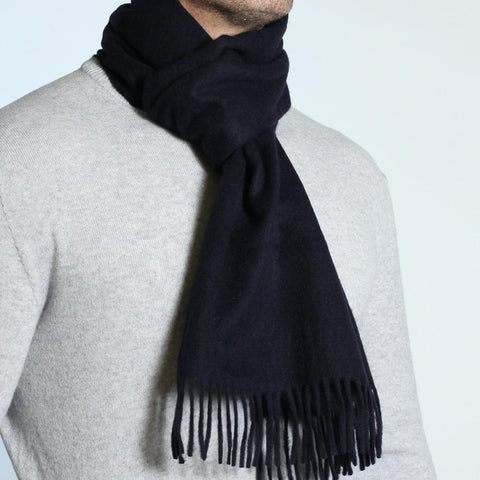What to Wear When It’s Freezing Outside?
In the famous words of a well-versed fantasy genre television show we all know and love, winter is indeed coming. Personally, we at Rampley & Co fully embrace the winter months as we feel menswear comes into its own. Whether it be the colour hues or layering options, or new shapes to play with, menswear in Autumn/Winter is the best time of year for style change ups.
Below, we wanted to give our updates on how to dress appropriately for the time of year with a sartorial statement and ease.
EXPLORE: RAMPLEY & CO OVERCOATS
THE WINTER COAT
We often get asked, what type of coat is best for winter? There are a few ground rules in fabric, shape and length, but otherwise, the choice is yours when it comes to your winter coat. Leave the bomber and worker jackets to the side and look for that statement overcoat or parka that will see you through the cold snap. Below we share our favourite options across the different menswear guises.
Overcoats
Wool is the optimum fabric to keep you warm during those plummeting temperatures and chilly mornings. When worn correctly, an overcoat or peacoat is the perfect final piece on top of your workwear or formal suiting, but it also can be dressed up or down with denim and trainers for casual settings.
Traditionally these standard menswear coats were made of heavy, scratchy melton wool in either navy or black. As the years have gone by, the wool used in making wool coats has softened, and the colours available have broadened to lovely browns, camels and greys as popular choices. See our favourite 100% wool camel overcoat here.
How to Wear?
The overcoat is versatile and can be worn formal or in a casual manner under your wool fabrics. Suits, a white shirt and a check tie work perfectly for formal occasions or the office. For winter accessories, ensure you team your overcoat with a cashmere scarf either draped or in a tie knot; see our scarf guide here.
Puffers
You may have seen these thick, wadded and heavy insulated coats everywhere over the last two years, perhaps due to lockdowns and having to explore our local nature and parks, but the puffer has become a new menswear classic. Ideally black and longer in length, the puffer has wadding added to keep you truly warm.
Puffer jackets, also known or sold as quilted jackets, have a signature quilted design with sections that are “puffy” between the stitching. They are filled with down insulation (the less sustainable option) or synthetic fibres, both of which can provide a high level of warmth depending on how well they are made and the quality of the synthetic fibres.
Parkas
Often associated with the 90s and a certain rebellious Manchester indie band, the parka has been off-trend for the last decade; however, styled right and a play one fabric and techniques has created a new life for this faux fur-trimmed coat.
Parka jackets were created for the sole purpose of blocking out the cold wind and keeping the body heat from escaping, so they seem the obvious choice to keep warm. Classical parkas are equipped with a fur-lined hood that wraps around the neck and head with volume, with a long length and fishtail back, which originates from its artic seal hunting heritage.
Newly revived parkas are now seen with quilt stitch details and a play on fabrics such as Borgs and Nylons and additional utility-style trim updates. Perfect for long walks or city breaks, the parka can see you through the winter months in style.

Peacoat
The history of the peacoat is deeply rooted in military and naval backgrounds. Surprisingly, the jacket has been around since the 1800s when the first variation was worn by then naval powerhouse, the Dutch. The name peacoat originated from the Dutch word “pije”, which was used in the Dutch language to describe a coat made from coarse wool fabric. Similar to the overcoat, the shorter versions are traditionally made from heavy wools and are seen in true Navy Blazer colours across most retailers. However, it’s not uncommon to see grey marls and black colours in this shape if you are looking for a different option.
How to Wear?
Peacoat works perfectly with smarter, more formal wear due to the heavy workmanship and pointed lapel design. Pair a classic peacoat with a camel or brown cashmere scarf for a stylish look that is muted in colours but abundant in class. Layer with cable knitted jumpers in cool winter tones such as blues and grey for a complimentary choice.

Duffle Coat
Made famous by a fellow English treasure, Paddington Bear, the Duffle coat is named after the Flanders clothmaking town of Duffel. From this, a coarse, thick, waterproof black woollen fabric was once used to make protective clothing (today, both spellings duffle and duffel are acceptable).
The best asset of a duffle coat is its versatility, as it can be worn with suits, uniforms and casual attire, but like its wool counterparts, it is often seen more in formal settings. The duffle's enduring appeal is undoubtedly thanks to its simplicity and practicality, essentially unchanged for over a century.
 Source: FemaleFirst
Source: FemaleFirst
TRANSITIONAL JACKETS
Safari Jacket
A safari jacket is commonly a lightweight cotton drill or lighter poplin jacket, traditionally khaki in colour, with a self-belt, epaulettes, four or more expandable bellows pockets and often with cartridge loops. Its origin comes from lightweight, light-coloured uniforms were worn by European soldiers serving in warm climates from the 19th century and, little altered, throughout World War II.
More of a summer casual jacket or perfect for the transitional months of September and March, the safari jacket is designed to be the star of the show, so allow it to take over and avoid wearing anything else that attempts to compete with it for attention. If in doubt, muted basics are the order of the day, so throw it over a simple T-shirt for layering and pair with dark based slim denim or navy chinos for an effortless look.
Bomber Jacket
A menswear icon and go to summer jacket, but why is called a bomber jacket? Based on history, the very first bomber jackets were worn by military pilots during World War I and II hence the name being drawn from realistic elements at the time. In World War I, most aeroplanes did not have an enclosed cockpit, so pilots had to wear something that would keep them sufficiently warm. Hence the term, flight jacket.
The U.S. Army officially established the Aviation Clothing Board in September 1917 and began distributing heavy-duty leather flight jackets; with high wraparound collars, zipper closures with wind flaps, snug cuffs and waists, and some fringed and lined with fur. In the 1970s and 1990s, flight jackets became popular with scooterboys and skinheads. In the 1980s, a baseball-style bomber jacket became popular.


Source: CockpitUSA
How to Wear?
Bomber jackets are paired superbly with mid to light wash denim, in a variety of cuts. More modern styles are seen in some core colours; black, red, olive and burgundy.
Mostly suited to casual occasions, a bomber jacket makes a perfect outerwear choice and can easily be worn with jeans, chinos, or casual trousers. A logo or classic t-shirt is good for layering while for footwear, the natural go to choice are trainers or sneakers.
SITUATIONAL JACKETS
Trench Coat
A symbol of quintessential British style and worn primarily on city and office workwear, the origins of the trench coat date back through to the 1820s. The trench coat, once military uniform, is now the go-to coat for a sophisticated ensemble in the 21st century. Like many of the coats features, its origin comes from wartime clothing for practicality. The length and cut, with the adjustable belted waist, made it a flattering shape for men and women.
Made famous by Mr Thomas Burberry, the trench coat is a popular style in Hollywood films and was worn by detectives, gangsters and femme Fatales alike during its rise through the last 100 years.
 Source: Fashion Gone Rouge (Burberry)
Source: Fashion Gone Rouge (Burberry)
How to Wear?
A traditional trench coat has a double-breasted front with ten buttons, wide lapels, pockets that button-close, and a storm flap. It also has a belt at the waist and straps around the wrists that you can buckle. Ensure the length is below the knee for a draped effect and the shell fabric is a classic stone or beige colour of choice.
The trench coat works perfectly with handmade ties and classic striped designs for proper layering and office wear. Navy, blues and grey work best against the neutral trench base colours.
Wax Jackets
A Waxed jacket is a hip-length jacket made from waxed cotton cloth, iconic of British and Irish country life. The wax jacket is commonly associated with countryside explorations, such as walking, fishing and travel. It is a cotton jacket made water-resistant by a paraffin-based waxing, typically with a tartan lining and a corduroy or leather collar. However, the main drawback of a waxed fabric is its lack of breathability.
Wax jackets started being mass-produced in the 18th century in Scotland by a pioneering company called Francis Webster Limited. Their unique waxing treatment was to infuse the cloth with linseed oil; they became so popular that they even supplied the British Navy. Their early work formed the basis of wax cotton as we know them today.
As suggested, the best outfit build for a waxed jacket is through outdoor attire. For example, desert or hiking books work perfectly with chunky rolled wool socks. Denim is usually black, or dark washed, with layering in the form of chunky knitwear such as a quarter-zip or roll-neck cashmere jumper.
 Source: Fife Country
Source: Fife Country
LAYERING GUIDE
The natural instinct to keep yourself cosy is to add layers, but what is a layering piece? It’s the way we wear garments on top of each other (in layers) to help add texture, colour details or have more warmth in our outfit. We set out three key rules to help guide you.
1. Start thinner, work your way up - it might sound basic, but it’s a simple rule to stick by. The base layer is usually a t-shirt or vest that is lightweight and closest to the body; layer two is a jumper or knit, with a final jacket or coat on top. Each layer should be more weighty and thicker than the previous and go up in scale accordingly.
2. Three-layer rule - we like to stick to three layers maximum as a guide; feel free to add scarves and accessories to an outfit if you don’t feel warm enough. Once you start to go over this, the outfit can look clunky and unflattering. Don’t feel like you have to stick to the t-shirt/jumper/coat items; for example, a shirt and blazer work well, or a long sleeve top with a lighter cardigan also can be executed perfectly.
3. Ensure your layers work as separates - layers are there to keep you warm while it’s freezing outside, but usually, you’ll end up at your workplace, dinner setting or inside, so the final items tend to come off. Ensure your middle layers are suitable in terms of outfit combinations. Do they pair well with your trousers/denim when a standalone? Often people focus on the final layered piece or the coat and forget these important details.

Source: The Dark Knot
DOES MY HAT AND SCARF HAVE TO MATCH?
Often a question we get asked but in short, no, not necessarily. We do have to admit the simplest way to coordinate is to match the colour (pattern or solid) of all three of your Winter accessories. However, you can play with pattern mixing as long as they complement.
Match Two Items
A sometimes easy and quick win is to match your gloves and scarf with a solid base colour that is tonal to your overcoat or jacket. This adds textures and layers to your shape and outfit without new colours. If ever unsure, this is a safe way of adding accessories without clashing.

Compliment & Create
It may seem hard on the surface, but wearing a hat, scarf and pair of gloves that aren’t an exact colour or pattern match but complement each other and work well with the other components of your outfit can be a true style winner.
The key to pattern mixing is the colour hues; this is ensuring that your patterns are from similar colour families and create complementary palettes. For example, a navy tartan check scarf with red highlights can be teamed with a solid hat or gloves in a similar red solid. Or a cream textured stripe that can be paired with off white gloves as they sit together in the hues and will combine with your outfit.


CONCLUSION
Hopefully, you are now fully equipped and suitably set to face the winter world head-on with some of our tips and outfit guides. We know that staying warm is the main aim of the game, but why not have some creative fun with your new winter wardrobe at the same time? Be sure to check out our latest 100% cashmere winter accessories collection to pair your combinations effectively.
Shop Our Winter Scarves Collection





